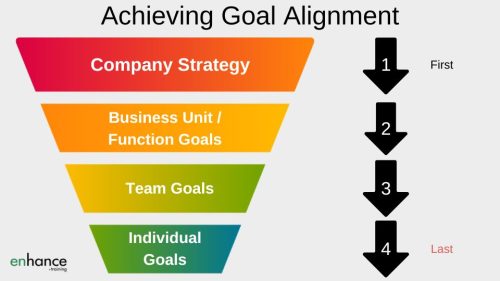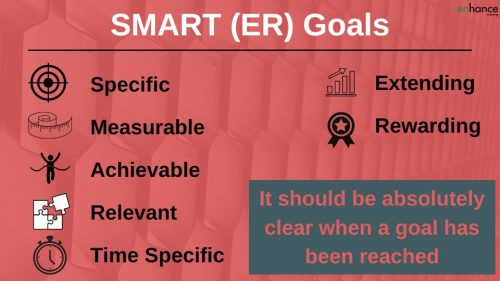How to set objectives for the team

How to set objectives for the team is a task that most managers go through at least each year. In this article I take you through a tried and tested approach to set clear, actionable, objectives which have team member buy in.
If you are going to put the effort into setting objectives, you want to ensure that your objectives help drive accountability and help increase the performance of the team. By doing both, the time taken to set objectives will be repaid in benefits to you, your team, and the company.
At the end of the article, I give you suggestions on how to go about measuring progress against your objectives which is super important in keeping the objectives front of mind for the team so keep watching.
Too many people fear creating really good objectives. And I understand why – there is always the worry that your boss will haul you over the coals if you don’t achieve them, yet if you don’t have specific objectives, how will you or your boss know when you have met them?
This Article Covers:
Objectives – a double edged sword
- Start with the end in mind
- Start with company strategy / top-down approach
- Build the objectives with the team
- Make objectives specific or SMART
- Work out how to measure progress
Watch on YouTube
Listen on Podcast
Objectives – a double edged sword
Many managers and companies make their objectives too vague to be useful. Creating vague objectives does help reduce the ability of your boss to hold you to account and it also reduces your ability to prove you have met your objectives. So vague objectives might be safer. They are definitely a lot less useful in driving performance.
I would suggest that you fight over the level of the goals attached to the objectives rather than making your objectives vague. Vague objectives don’t help anyone in the long run.
Everyone should know when you have reached your objectives. You, your team, your manager and anyone else that takes an interest. This really is in your interests if you want to ensure your team perform and therefore you can perform too and meet your goals.
Learn more about why you should set objectives for your team.
Let’s go through an objective setting process.
How to set objectives for the team: Start with the end in Mind
When setting objectives for your team, it is essential that you start with the end in mind. What are you trying to achieve in the period to which the objectives relate.
For example, if your business has a key goal of adding 15 customers in the US, and your objectives are all about Europe, then it is unlikely that you will achieve your US goals.
Getting very clear about what you want at the end of the period in question is one of the bigger challenges in setting objectives.
I would suggest that you don’t use financial goals as your key goal. Finance performance is an outcome of sales, marketing and operational activities. And most people don’t relate to financial information very easily. Financial information is a way of measuring performance not the activity driving that performance.
So rather than having your key goal of increasing sales by $100,000, you could have your key goal of increasing the number of customers by 15. This assumes that each customer would spend on average $6,667.
You could then break down your team into individual objectives focused around all the activities that need to support increasing customer numbers by 15 in the US.
Make sure that you are really clear on the end goal or objective before you start translating these into team and individual objectives.
How to set objectives for the team: Start with the Company Strategy or a top down approach
When setting objective for the team, you should always approach it top down.
An obvious place to start when setting objectives for the team would be to look at the company strategy, assuming that your strategy is clear about what it is trying to achieve over what timeframe.
If you don’t have a strategy or a set of goals at company level, then work on these before setting objectives and goals for your team.
Your objectives flow should look something like this starting at the top and working down.

This ensures that all your objectives and goals are aligned.
Each individual will be doing the work so to get everyone working in the same direction and support each other, you must set the company objectives first and then move down into the next smallest group, until you get down to the individual.
If individual goals and objectives are not supporting the team goals and objectives, then it will make it much harder to achieve the team objectives. Everyone benefits if the company reaches its goals in terms of more stable jobs, more personal development opportunities, bonuses etc.
Set objectives and goals by starting at the top – the largest group – and working downwards to the individual.
How to set objectives for the team: Build the objectives with the team
There are lots of ways of setting objectives for the team. You could choose what they are and tell the team what they need to achieve. This approach means that you are imposing your objectives and goals onto the team without the team getting any or much input. Their ownership of the objectives you created is likely to be a lot lower.
If you want to the team to really own their objectives, get the team to create or help create their objectives.
Set out the key goals i.e. where we as a team want to be in a year or x months. Make sure the goal is clear, and everyone will know when we have reached it.
Ask the team how we are going to achieve it
Then ask the team for ideas on how we are going to achieve the goal. The most important thing you can do is not give them your answers. Sit back, listen to what is being said. Ask questions to prompt them, but don’t give them your answers. Be patient. They will come up with answers once they know you will not give them what you are thinking. (or at least not until they have given their answers)
Facilitate the discussion and challenge where necessary. You are looking for the team to arrive at a method or approach to achieving the goals that you have set out that is realistic, stands up to scrutiny and can be achieved.
This approach takes more time, takes more effort on your part but you have a team that owns the objectives. After all, they each created the plan of how to achieve the goals.

If achieving the goals appears unrealistic
If it appears that achieving the goals is unrealistic, then challenge the team to identify and document the key assumptions limiting them in achieving the objectives or goals.
Having the key assumptions is really important. You can use them to negotiate a change in one or more of the assumptions or a change in the team objective or goal.
A classic example is needing more resource – time, skills, capacity, cash etc – to achieve the goals requested. If you haven’t gone through the detail of how to achieve the goal and the assumptions, negotiating a different goal or a change in resources is a lot harder.
How to set objectives for the team: Make your objectives specific or SMART
If you want to have objectives against which you measure progress and everyone knows when the objective has been reached, the objectives must be specific and detailed.
SMART is a popular acronym detailing out the components of useful objectives.

You need all or as many of these components in your objectives to make it clear to you, your team, your manager and anyone else when you have achieved your objective.
If you are struggling to work out how to measure progress against your objective or the end point is not clear, then keep working on your objectives until this is very clear.
You are then able to hold people accountable to the objective and goal which will improve performance if used in the right way.
How to set objectives for the team: Work out how to measure progress
Having worked out what your objectives are at team and individual level, you now need to measure progress against those objectives to:
- Keep people focused on their objectives
- So everyone knows where they are against their objectives
- You can take correcting action as needed
- You know when you have achieved your objective
Choosing what you are going to measure is very important. This choice will drive behaviour of the team and the individuals. Especially when rewards are tied to achieving objectives and the measurement determines if the objective has been achieved.
Keep what you choose to measure as simple as possible to collect and collate. If you have a complex measure that takes loads of time to collect and then put into something useful, chances are you or a team member will stop measuring it or the time spent will interfere with achieving the objective.
Keep it simple and easy to measure.
Here are some simple examples:
Consultancy productivity – number of billed hours versus total hours (time sheeting would be needed)
Number of bottles sold – add up all the orders in a given time frame that have been dispatched from the warehouse (stock management system needed)
Achieving 15%+ in profitability – would need the finance team or your system to produce a suitable report
Number of new customers – new contracts signed or new customers that have paid their first invoice (legal or finance teams would need to provide you a report)
Think carefully about what you are going to measure and how you are going to measure it simply, quickly and without incurring lots of additional cost (or time).
In Summary
How to set objectives for the team and do this well is not as easy as it first appears. Get your objectives right, the team bought into achieving them and being able to measure progress easily against each objective and you should have the foundations in place to increase ownership and drive team performance. And you also make it a lot easier to reward and get rewarded for great work.
Setting useful clear objectives is well worth the effort in terms of what you get back.
Enjoy managing and leading your team!

I have been involved in turning around business and team performance multiple times, and one of the first things we do is set goals and objectives because it is so important to improving performance.
It’s also a great way to involve the team members in owning individual performance as well as the team and ultimately the company’s performance.






